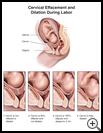
Labor and Delivery
________________________________________________________________________
KEY POINTS
- When labor starts, you will have regular, strong contractions that are 2 to 3 minutes apart, last 30 seconds or longer, and make your cervix start to thin and open. How long labor lasts and how it moves forward varies from woman to woman and from birth to birth.
- During prenatal visits you and your partner should talk with your healthcare provider about any questions you have about labor. You should also talk about procedures that may become needed during labor and delivery, such as C-section.
- It is helpful and important for you and your partner to take prenatal classes to learn more about labor, delivery, and postpartum care.
________________________________________________________________________
What is labor?
You are in labor when the muscles of your uterus contract so that your baby can be born. During labor, the uterine muscles tighten and the cervix (the opening of the uterus) thins and opens. The baby moves down the birth canal to be born. After delivery of the baby, the placenta (afterbirth) also comes out of the uterus. This is the last part of labor.
Every labor is different. How long it lasts and how it moves forward varies from woman to woman and from birth to birth. There are, however, general guidelines for labor that a healthcare provider uses to decide whether it is progressing normally. If it is not progressing normally, you may need medicines to help it along or a C-section.
If you have signs of labor before 37 weeks of pregnancy, the labor is called preterm. You should call your healthcare provider right away if you have any signs or symptoms of labor before 37 weeks.
How does labor start?
No one knows exactly what starts labor. We do know that hormones cause uterine contractions and the thinning of the cervix. Perhaps hormones from the baby trigger labor by causing the mother to make more hormones.
Labor starts when uterine contractions are strong and frequent enough to make the cervix open and thin. Signs that your body is getting ready for labor are:
- Passing a small amount of blood-tinged mucus from the birth canal (vagina). This discharge is called "show" or the mucus plug. It may occur 1 day to several weeks before labor actually starts or it may happen after a pelvic exam.
- A trickle or gush of water from the birth canal. This is caused by a breaking of the amniotic sac, also called the bag of waters. The amniotic sac surrounds the baby. If your bag of waters breaks, contact your healthcare provider right away and go to the hospital.
The sign that labor has actually started is regular, strong contractions that:
- Are 2 to 3 minutes apart
- Last 30 seconds or longer
- Make the cervix start to thin and open
Sometimes it’s hard to know when labor has started. You may be admitted to the hospital and then be sent home if your labor does not cause your cervix to thin or open.
What happens during labor?
You and your baby will be checked throughout labor. The 3 stages of labor are:
- First stage: The cervix opens and thins until it is wide enough for the baby to pass through the birth canal.
- Second stage: The baby moves through the birth canal and is born.
- Third stage: The placenta (afterbirth) passes through the birth canal and is delivered.
By the end of the first stage, the cervix has dilated fully to 10 centimeters (cm), or about 4 inches. The first stage of labor usually lasts several hours.
- Early labor, or prelabor, is when the cervix is 0 to 3 cm dilated. The contractions are irregular and mild.
- Active labor begins when the cervix is 3 to 4 cm dilated. During active labor the contractions usually get stronger and more regular. During this time the contractions are usually more painful. If this is your first labor, you will likely dilate about 1 cm per hour. If you have had a baby before, the cervix usually dilates faster.
The baby is born during the second stage of labor. This is when you push the baby down the birth canal. This stage of labor usually lasts 15 minutes to a little over an hour, but it may last as long as 2 or 3 hours. How long it takes depends on if you have had previous births, the position of the baby's head, the size of the baby, and the size of your birth canal. Sometimes medicine for pain, such as an epidural anesthetic, may slow labor.
During the third stage of labor you deliver the placenta. This usually happens within 30 minutes after the baby is born.
The first few hours after delivery are called postpartum recovery. During this time, you will keep having contractions as the uterus goes back to its normal, smaller size. Medicine is usually given through an IV to help keep the uterus contracted and to keep you from bleeding too much. You will have a small amount of bleeding for the next couple of days.
How can I prepare for labor?
During prenatal visits you and your partner should talk with your healthcare provider about any questions you have about labor. Discuss how you will manage pain and whether or not you want medicine to lessen the pain of labor. You should also talk about procedures that may become needed during labor and delivery, such as C-section, and ask any questions you have.
It is very helpful and important for you and your partner to take prenatal classes to learn more about labor, delivery, and postpartum care.

